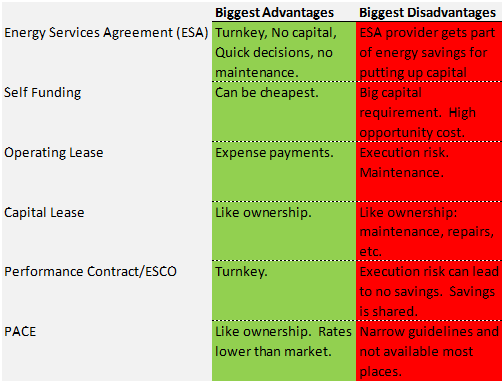CIMI Energy’s funding partner is a premier provider of Energy Services Agreements (ESAs). ESAs provide organizations with off-balance sheet funding for energy retrofits. For the term of the agreement, the provider of the ESA maintains ownership of the equipment, and provides maintenance. Energy costs are paid by the customer, with the ESA provider receiving compensation through a portion of the energy large energy savings.
Owner execution risk is low, and there are NO upfront costs. The net result for the customer organization is a reliable and cost-saving energy system that requires no cash and no debt. It’s an off-balance sheet solution with short and long-term benefits. For more details on ESAs, visit CIMI Energy’s ESA page.
Alternatives to ESAs
Self Funding
Energy retrofits can be achieved in a number of other ways. The most common way is self-funding, either with cash on hand, or with a combination of cash and borrowing. However, because the capital costs for large energy retrofits can be very high, this requires tying up a lot of capital. Furthermore, by planning and investing capital for purposes outside the core mission of the organization, management can get distracted, and takes on execution risks.
Nevertheless, if an organization has a lot of free capital, and no higher yielding alternative uses, this can still be a good approach. But if the organization can use that capital for other purposes, either right away or off in the future, then it’s prudent not to spend it on an energy retrofit.
Operating Lease
There’s less upfront capital required with an operating lease, and less execution risk than self funding. An operating lease is essentially renting, and payments are expensed. This method of funding is not suitable for many types of integrated hard assets such as heating and cooling equipment, and other large equipment that’s an integral part of a building system.
Capital Lease
A capital lease is attractive for having low upfront cash requirements. The downside to capital leasing is that the responsibility for project management and ongoing maintenance falls upon the lessee. These are small issues when the products are straightforward, as is the case with trucks, furniture, and computers. For complex projects like large energy retrofits, this is a management responsibility that can require added manpower.
Performance Contract / Energy Services Company (ESCO)
Performance contracts, also known as Energy Savings Performance Contracts (ESPCs) or Energy Management Services (EMS) have achieved some popularity in recent years. They provide a way to fund capital improvements for energy management, maintenance, and energy generation. They typically bundle together investments with short and long-term paybacks, with a resulting medium-term payback for the bundle.
The ESCO is the entity that proposes the ESPC (or EMS), and that carries the responsibility for engineering & design, equipment purchasing, construction management, maintenance, training, measurement and verification (M&V), etc.
Upfront capital costs are high. On the other hand, there is a performance guarantee for up to 20 years as part of the contract. Savings are shared between the organization and the ESCO.
Power Purchase Agreements (PPAs)
Similar to ESAs (see at top), Power Purchase Agreements (PPAs) require no capital, and have low execution risk. While ESAs are for efficiency, PPAs are for power, typically produced on site. A typical example is an installation of a large power producing asset, such as a district heating plant, where power produced is billed, as is the heat (byproduct).
Property Assessed Clean Energy (PACE)
PACE loans are loans which are paid for through property taxes. They are specific for what they can be used for, with energy reduction or efficiency upgrades being accepted investments. As they are geography-specific, they are only available in some communities.
CIMI Energy partners have the experience and expertise to manage PACE-supported projects, and others. Together we can find the right balance of risk, capital, project management, and ongoing equipment management to meet your goals.
Summary


